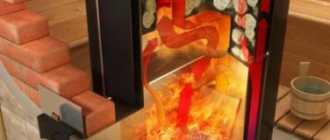Since ancient times, it was customary to go to steam, warm up and wash in a bathhouse once a week. There was consistency, there was habit and a kind of “bath hardening”. Now you can often hear that the soap kingdom has become some kind of wrong place. Often after a bath we feel bad, a variety of ailments arise, headaches, nausea, and so on.
The causes of poor health are varied and the bathhouse, heat, steam and hot water are not always to blame. But there is no need to treat bath procedures as innocent entertainment.
This is not the first time I have said that the bathhouse can severely punish reckless behavior, unnecessary daring and the desire to set records. The bathhouse must be respected and taken seriously. Any mistakes are immediately punished with poor health.
Why does it feel bad after a bath and what ailments are possible?
Not everyone can stay in a closed, hot and humid room for a long time. Injecting heat and steam is nothing more than creating high temperatures and humidity. This is what provokes an increase in blood pressure, shortness of breath and weakness.
Even “super-seasoned” bathhouse attendants go out to rest, cool down, douse themselves with cool water, bathe in sauna fonts, and plunge into the coolness of the river.
Man is created from flesh and blood, our body has a limit to its capabilities. You should not try to set records for staying on a bath shelf. The first law of the bath is the alternation of heat and cold, mandatory contrasting water procedures.
What to do if you overheat
As a rule, heat stroke does not develop immediately in a bathhouse. At first, a person may feel slight discomfort, after which it is necessary to immediately complete the bath procedures. You should wash your face with cool water or douse yourself completely, and go to the dressing room.
If possible, you should lie on a flat surface and your head on a slight elevation to stabilize the pressure. Next, it is important to restore the water-salt balance. To do this, drink plenty of cool, but not icy, clean water.
Note! Soda, juice or alcoholic drinks are not suitable.
When your health has stabilized, you can start to slowly get dressed and go out into the fresh air. If you can’t get up on your own, it’s better to wait for help from your loved ones.
Red spots on the skin
The appearance of red spots on the skin during or after a bath is a normal reaction of the body. Blood moves in the body not only through veins and arteries. Faithful assistants of the circulatory system, capillaries play an important role.
Capillaries form a huge subcutaneous mesh that covers every part of our body. In ordinary, everyday life, we do not even notice the enormous work that capillaries perform, delivering blood to the most secluded corners.
As soon as there is an increase in body temperature, blood flow to the capillaries increases. In some areas of the skin there are more capillaries, which is why redness occurs.
When hovering with a broom in normal mode, the blood vessels are stimulated, blood flows faster, which is why the skin turns red. But, if you hit the body with a broom with all your strength and stupidity, you get real blood stains and even bruises. The capillaries are injured and, as a result, simply burst.
Red spots on the skin during and after a bath are not at all dangerous.
The redness will go away as soon as the body temperature begins to subside, blood flow decreases, and heart contractions return to normal. How to do this?
You need to douse yourself with cool water, sit and relax in the dressing room, drink some water.
The main reasons why visitors feel unwell after bathing procedures
It is worth noting three main reasons for feeling unwell after taking a bath, and they all have different sources.
Constructive miscalculations in the design and construction of a bathhouse
These include:
- Incorrectly functioning supply and exhaust ventilation or its absence, as such. As you know, both a person and a sauna stove need air, or rather the oxygen contained in it, as a powerful oxidizing agent, to live and function. During fuel combustion, due to supply ventilation, the lack of oxygen is replenished, and due to exhaust ventilation, combustion products that were not removed through the chimney and entered the internal volume of the bathhouse are removed. It is worth emphasizing that fuel combustion under conditions of insufficient thrust and, as a result, oxygen deficiency, can provoke the formation of carbon monoxide - carbon monoxide, an extremely dangerous and insidious enemy.
- Insufficient volume of the steam room, and as a result - the difficulty, and sometimes the impossibility, of regulating the temperature and humidity balance. This problem is especially acute in small baths, where an increase in steam room space leads to a proportional decrease in the internal volume of other functional areas. This also includes the fact that the presence of effective ventilation in small steam rooms is a critical tool for its normal functioning. It is for this reason that in small-sized baths, such as those measuring 2x3 m, heater stoves have an electric heating source that does not require oxygen, even at peak operating conditions.
- Irrational placement of shelves in the steam room space. These factors can manifest themselves in different interpretations. For example, the location is too close to the stove, especially if the stove is metal, which can cause high-intensity thermal radiation directly onto the shelves. Or, the inability to take procedures while lying down, when all areas of the body are in an area with the same air temperature. This also includes the crowded space for receiving procedures and the location of the upper shelves at too high a height from the floor level, in the zone of the most extreme temperatures.
- Lack of devices for monitoring temperature, humidity and timing the time spent in the steam room. We have already described in detail how important clocks, bath stations and thermometers are in a bathhouse for the safe administration of procedures and monitoring their implementation.
- Use as construction, insulation and finishing materials that do not meet the requirements of environmental safety and sanitary hygiene. The same fully applies to fuel for sauna stoves and firewood, in particular.
Presence of chronic and acute diseases, as well as allergic reactions among visitors
We have already written several times that medicine imposes restrictions on visiting the bathhouse for a number of diseases. Here are the most typical ones:
- Body temperature consistently exceeds 37.8 degrees Celsius;
- Hypertension, especially in the acute stage, associated with seasonal or weather factors;
- Diseases of the cardiovascular system;
- Oncological diseases;
- Pulmonary tuberculosis, in the open form of the disease;
- Nosebleeds and heavy menstrual periods;
- Bronchial asthma, during the period of exacerbation of the disease;
- Skin diseases, including those provoked by fungal bodies, provided that during a given period of time the affected areas could not be localized with medications or other therapeutic agents.
By the way! It is a rule of good manners to consult with your attending or specialized doctor before becoming a regular visitor to your favorite bathhouse.
Gross violation of generally accepted rules and regulations
We, through one, are all heroes with iron health and nerves of steel, and this quality is usually emphasized in every possible way and from time to time confirm, so to speak, qualifications. Typically, heroic prowess consists of drinking from 0.75 to 1.0 liters of vodka to the approving accompaniment of feast partners or eating a double portion of shish kebab with a side dish of a can of freshly grated horseradish or 5-6, or even more pods of hot pepper. The “weak” reaction is very often activated in the bathhouse. Here are the most typical and egregious examples:
- Critical excess of temperature and humidity balance in the steam room. We have already talked about what the correct pair should be. However, for a certain category of users, who are either ironically or respectfully called “immortals,” it is customary to accelerate the furnace in a way that a team of selected stokers on record-breaking ships failed to do during the race for the Blue Ribbon of the Atlantic prize. At the same time, when the air temperature goes beyond 120 degrees Celsius, it is also customary to generously pour liquid on the stove stones, according to the classics - beer, which is why clouds of viscous and heavy burning steam fill the volume of the steam room, displacing the air from it and, as if in reality, the picture from the song “Spread Out” is drawn The Sea Is Wide" is about a Russian fireman who died of heatstroke during a voyage to the Red Sea.
- Staying during the procedure exclusively on the top shelf, and very often unique “marathons” are organized for the duration of a non-stop stay in a paired room.
- Bathing in an ice hole, without any temperature transition, preparation or pause. In certain circles it is believed that the greater the difference in temperature, the shorter the period of time between the steam room and the ice hole, the more effective “gymnastics for blood vessels”.
- Crazy and thoughtless use of coronary massage, when the special valor is considered not the subtle and precise impact on various parts of the body, but the frequency and, most importantly, the force of the blow. The negative impact of this approach especially appears when the broom is prepared incorrectly or is used for other purposes, for example, a bamboo broom, which is fashionable in certain circles. Working your partner with a heavy oak broom until he misses half of the work week due to the inability to move independently means showing the highest degree of respect.
- Abuse of smoking and alcoholic beverages. It is worth recalling that the slipperiness of the floor and the sharpness of the corners directly depends on the amount of beer drunk before entering.
- Excessive concentrations of salts, oils and flavors. This trend can be seen especially clearly among the fair half of humanity. This also includes independent herbal medicine and witchcraft. Fortunately, the number of “specialists” on the Internet who are ready to share their secret “family recipes” with the audience around the clock is growing exponentially.
By the way! Unscrupulous people also play an important role in negative manifestations, passing off synthetic chemicals that resemble essential oils with only a vaguely similar smell as natural, environmentally friendly products made exclusively from plant materials.
Redness of the eyes
Most often, bathing beginners encounter redness in the whites of their eyes. A microscopic red capillary network appears in the corner of the eye. This is already a serious sign of deterioration in well-being.
Most often this happens in people prone to high blood pressure and newcomers to the bathing kingdom.
Not everyone can handle high bath temperatures. If you just get carried away in the steam room, sit on the top shelf longer than the allotted time, your eyes will turn red.
To avoid such troubles, it is necessary not only to reduce the time you enter the steam room, but also be sure to monitor the time you spend in it. A bath cap is necessary to protect your head from overheating.
You need to go out to rest more often, be sure to douse yourself with cool water and drink plenty of fluids.
What else can a steam and broom enthusiast get as a reward for his fanaticism?
Burns are a common nuisance for bath and sauna lovers. You can get burned by steam, hot water, or accidentally touch a hot stove. Are there not enough options for craftsmen? In any case, you need help immediately. It is better to place the burn area under cold water and keep it running for twenty to thirty minutes. If the skin is red, but there are no blisters, you can lubricate the damaged area with alcohol or cologne. If there is a severe burn, this should not be done: a painful shock may occur. Simply make a sterile dressing from bandage, gauze or cloth. Do not puncture the resulting blisters under any circumstances - an infection can get into the wound, which is very dangerous! Sometimes it is recommended to apply a tampon soaked in a solution of potassium permanganate or ammonia. But not all doctors agree with this, so it’s better not to experiment. After providing first aid, take the patient to the doctor, even if the situation does not seem serious. The consequences of a burn are difficult to predict; let the doctors deal with it.
Dark circles and darkening in the eyes
There are several reasons for the appearance of dark circles and darkening in the eyes:
- When there is a pressure difference between the upper torso and the lower
- Ailments can be triggered by a difference in blood pressure in the body and atmospheric pressure - the body does not have time to rebuild and adapt to the bath climate
- Blood did not reach the brain in the required quantity, it did not receive the necessary nutrition
- High bath temperatures, stuffy room, stale air
Rest in a ventilated, cool room, drinking plenty of fluids and sweet candy will help you cope with the illness.
It is advisable to lie down to rest, placing a damp, cool towel on your head.
Symptoms of Heat Stroke
Heat stroke in a bathhouse is a painful condition that is dangerous to life and health. In a hot room, the body is unable to maintain normal body temperature, and the general mechanisms of thermoregulation are disrupted.
The first signs are:
- Feeling of weakness, lethargy, dizziness, heaviness in the limbs.
- A sharp increase in body temperature up to 40 degrees.
- Increased heart rate and palpitations. The tremors are so strong that many say that “the heart is jumping out of the chest.”
- Breathing is frequent and shallow.
- A sharp drop in blood pressure, accompanied by a “rumbling” in the ears.
More severe symptoms of overheating include:
- nausea;
- convulsions;
- uncontrolled urination;
- paralysis of the respiratory and vasomotor centers can lead to death.
When the first symptoms appear, you should leave the steam room or help the victim leave.
Why does heat stroke occur?
You can get heatstroke in a bathhouse if you don’t follow the basic rules for visiting it:
- long stay in the steam room;
- lack of body cooling procedures (swimming pool, shower);
- hard physical labor;
- obesity and excess weight;
- synthetic clothing, which prevents oxygen from reaching the skin and retains heat;
- medicinal hormonal treatment;
- bad habits (alcohol, nicotine addiction, etc.).
How long does heatstroke last?
Heat stroke appears suddenly, but can sometimes develop within 24 hours. The period of the painful condition mainly depends on the body and the presence of concomitant diseases.
With rapid development, the duration depends on the speed of first aid. Timely cooling and elimination of primary symptoms will help avoid the development of most negative symptoms.
Feeling sick in the bath
The feeling of nausea is far from an unpleasant sensation; I encountered such a problem twice:
- I went to the bathhouse on an empty stomach
- When I got burned in the bathhouse
We can deduce the law of the appearance of nausea in a bathhouse - it occurs when there is insufficient blood supply to the brain, low blood hemoglobin, and poisoning with toxic carbon monoxide or carbon dioxide (for example, from smoking).
In the hot sauna kingdom, the following happens: the blood vessels of the brain expand when exposed to heat, and as a result, the pressure decreases.
There is a shortage of red blood cells in the circulating blood volume; in other words, the brain lacks oxygen supply. The body begins to save itself - systolic pressure rises.
This is the upper pressure indicator - the force of blood pushing out by the heart. The heart begins to contract more strongly, and the level of blood ejected into the arteries increases. Nausea and dizziness appear.
To avoid such troubles, you need to maintain the temperature in the bathhouse and not overheat. And before the bath you need to eat lightly and, of course, not smoke.
Well, I wrote in a separate article why people get burned out in the bathhouse and how to prevent such mistakes. Follow the link and get acquainted with my sad story, as well as what to do in such cases.
Providing first aid for illnesses
If you have a headache after a bath or serious signs of illness appear, what should you do in this case?
First of all, it is not recommended to go outside quickly, especially in winter. A sharp change in temperature can aggravate a person’s condition.
It is enough to lie down for 15 minutes in a well-ventilated room, placing a small pillow under your feet. This helps to quickly normalize blood pressure.
To relieve headaches, you can take painkillers - Nurofen, Citramon or No-shpu.
Medicinal herbs also help relieve pain. The following compositions provide a similar effect:
- St. John's wort decoction. Steam 1 tbsp in a glass of boiling water. l. herbs and leave for a quarter of an hour. The warm decoction is consumed after straining.
- Infusion of lemon balm or mint. 1 tbsp. l. pour a glass of boiling water over the herbs and leave for 10 minutes. The infusion is filtered and consumed warm.
- Decoction of elderberry leaves. For 1 tbsp. l. herbs take 1 cup of boiling water, leave for 25 minutes. It should be consumed strained with the addition of 1 tsp. honey
For hypertension, it is recommended to take herbal teas from chamomile and motherwort flowers; for hypotension, it is recommended to take herbal teas from the leaves of nettle, black currant and burdock.
To enhance the taste characteristics of herbal teas, you can add a teaspoon of honey to them.
When visiting a bathhouse, it is recommended to drink up to a liter of warm herbal tea, then sudden changes in temperature will not have a negative effect on the human body.
We recommend reading the article about healthy drinks when visiting a bathhouse.
Dizzy in the bath
Dizziness occurs for several reasons:
- Blood sugar dropped sharply
- Severe overheating of the brain
- A sharp outflow of blood from the brain
If you feel dizzy in the bathhouse, this is a sure signal that it’s time to end the pleasant procedures. You need to rest in a cool room, cool your overheated body, wipe yourself dry, change clothes and go home to drink tea!
You should not neglect alarming symptoms, because the body itself sends warnings about poor health. If you do not listen to such signals, then more serious consequences are possible, for example, loss of consciousness, fainting.
Emergency measures in case of fainting and poisoning
One of the basic bathhouse rules: “Never steam alone” implies the presence of people in the bathhouse who can provide some assistance in the event of various types of emergency situations. It is worth getting acquainted with the rules and principles of arranging bath doors, including in steam rooms. Therefore, we define the following algorithm of actions:
- The victim is evacuated from the steam room and placed in a cool place with a plentiful supply of fresh air. In the warm season, it is placed in the shade outdoors.
- An ambulance is called. This is especially important in case of carbon monoxide poisoning and fainting conditions. It is worth noting that it is difficult for a non-specialist to differentiate a fainting state from falling into a coma.
- In case of loss of consciousness, the victim is placed on his side to prevent the tongue from blocking the airways. If there is no pulse, resuscitation measures should be started, namely chest compressions and artificial respiration.
- The victim of heat stroke must be placed in a horizontal position, positioning the body in such a way as to exclude the possibility of choking on vomit if nausea is actively presenting. Cold compresses should be applied to the forehead and back of the head, and the body itself should be wiped or doused with moderately cool water, with a temperature of about 19 - 20 degrees Celsius.
- Violation of the body's thermal balance is associated with active loss of fluid, therefore, if the victim is in satisfactory condition, he must be given plenty of fluids, consisting of warm tea, water acidified with lemon, fruit juice or unsweetened juice or compote.
Lack of oxygen
There are other factors that can cause headaches after visiting a bathhouse, even in absolutely healthy people. These include, first of all, the lack of oxygen in the air. A heated stove actively consumes it, which is very noticeable in such a small room as a steam room. That is why you need to visit only those baths that are equipped with high-quality ventilation. These include our sauna in St. Petersburg.
Another reason that can lead to headaches is the presence of carbon monoxide in the steam room atmosphere. It disappears only when the wood is completely burned out. That is why you should always wait until the flame goes out completely, and remove the smoldering coals from the firebox, put them in a bucket and take them out of the room to extinguish them.
Allergic reaction
Everything here is quite simple: people like to use brooms from various plants in their baths, which release essential oils into the air when exposed to high temperatures. There is a high probability that a person will have a certain allergic reaction to these emissions, because in the bathhouse the pores on a person’s skin are expanded to the limit and easily let them in.
What to do: Take a cool shower.
Brain hypoxia
Don't be intimidated by this term: in fact, this is basic oxygen starvation. Among the reasons why people get headaches after a bath or sauna, it consistently occupies a central place. There is a logical explanation for this: people often set up a steam room on their own, violating various norms. As a result, ventilation in the bathhouse is disrupted, and the oxygen level rapidly drops. And the higher the temperature in the steam room, the more likely a person is to feel unwell in such conditions. And if you just have a headache, then, as they say, it’s not so bad. Cases of severe dehydration and loss of consciousness are common.
What to do: only fresh air and no stress, and also, you need to figure out what’s wrong with your bathhouse.











